
Original Link: https://www.anandtech.com/show/2237
Laptop LCD Roundup: Road Warriors Deserve Better
by Jarred Walton on May 22, 2007 5:00 AM EST- Posted in
- Displays
Introduction
Two of the areas where we've seen the most growth in the last few years are notebooks and flat-panel displays. The reasons for the tremendous growth differ, of course. Notebooks are a hot item because people are becoming enamored with wireless networks and portability, while LCDs have become popular because few manufacturers are making CRTs anymore and the small footprint of LCDs is desired by many people. We're working on increasing our coverage of both of these sectors, but up until now we haven't actually taken a close look at where they intersect.
Since the first laptops began shipping, LCDs have been the de facto display standard. Years before most people were using LCDs on their desktop, laptops were sporting these thin, sleek, attractive displays. As anyone who used one of the earlier laptops can tell you, however, the actual quality of the LCD panels was often severely lacking. With the ramp up in production of both LCD panels and notebook computers, you might be tempted to assume that the quality of laptop displays has improved dramatically over the years. That may be true to a certain degree, but with power considerations being a primary factor in the design of most notebooks, compromises continue to be made.
Without even running any objective tests, most people could pretty easily tell you that the latest and greatest desktop LCDs are far superior to any of the laptop LCDs currently available. While desktop LCDs have moved beyond TN panels to such technologies as S-IPS, S-PVA, and S-MVA we are aware of only a few laptop brands that use something other than a TN panel. (Unfortunately, we have not yet been able to get any of those laptops for review.) We have also complained about desktop LCDs that have reached the point where they are actually becoming too bright, in an apparent attempt to win the marketing war for maximum brightness. The same can't be said of laptops, as very few can even break the 200 cd/m2 mark. Individual preferences definitely play a role, but outside of photography and print work most people prefer a brightness setting of somewhere between 200 and 300 cd/m2.
Luckily, there are plenty of new technologies being worked on that aim to improve the current situation. Not only should we get brighter laptop panels in the near future, but color accuracy may improve and power requirements may actually be reduced relative to current models. LED backlighting is one technology that holds a lot of promise, and it has only just begun to show up on desktop LCDs. Dynamic backlighting - were the brightness of some LEDs can be increased or decreased in zones depending on what content is currently being shown - is another technology that we may see sooner rather than later. Then there are completely new display technologies like OLED.
With the current laptop landscape in mind, we have decided that it's time for us to put a bigger focus on the quality of laptop LCDs. To accomplish this we have put together a roundup of the current notebooks that we have in-house. Future laptop reviews will continue this trend by including a section covering display analysis and quality, but we wanted to build a repertoire of past notebook displays in the meantime. While we only have four laptops at present, it is also important to remember that there are only a few companies that actually manufacture LCD panels. We would also expect any companies that release notebooks with higher-quality LCDs to make a bullet point out of the fact, which means that if you don't see any particular emphasis placed on the display panel in a notebook's specifications it probably has a panel similar to one of the laptops we're looking at today.
Test Setup
We have covered this information in our desktop LCD reviews, but for those of you unfamiliar with some of the terminology used when discussing displays/LCDs we refer back to our Gateway FPD2485W review. The various specifications have become somewhat meaningless on the desktop, as the difference between higher contrast levels and higher quality isn't immediately apparent, for example. On notebooks, things are further exacerbated by the fact that most of the LCD panels don't list any specifications beyond the size and resolution. In some ways, this is the reverse of what we see on the desktop; we would almost go so far as to say that the manufacturers are aware of the poor quality of their laptop LCDs and they don't want to draw attention to this fact by listing specifications.
We couldn't dig up much information beyond the size and resolution, but we will provide actual measurements of some of the specifications later in this article. Here's a quick overview of the displays on the four laptops we're looking at today, all of which have been previously reviewed here at AnandTech. Hopefully, notebook manufacturers will begin to include more detail in their specifications in the near future.
| Laptop LCD Specifications | ||||
| Panel Size | Resolution | Panel Vendor | Penel Model | |
| ASUS A8Js | 14.1" | 1440x900 | CMC | CMO 1416 |
| ASUS G2P | 17.0" | 1440x900 | AU Optronics | AUO 4087 |
| Dell XPS M1710 | 17.0" | 1920x1200 | Seiko Epson | SEC 3155 |
| MSI S271 | 12.0" | 1280x800 | Unknown | Unknown |
Update: One of our readers suggested we try using a utility called Advanced System Information Tool (ASTRA32) to determine which LCD panels were actually being used in our test laptops. While we can't guarantee that the information is 100% accurate, it's at least something some of you will find useful. (Note for example that we were unable to get any details of the MSI S271 panel so far, but we will update the table if we can find updated drivers that will work with ASTRA32.) There is a very good chance that some notebook manufacturers will source LCD panels from more than one location, so for example the Dell XPS M1710 we have for testing may not be (and probably isn't) representative of all such laptops in the area of the LCD panel.
We mentioned in our review of the ASUS G2P that it had one of the best notebook LCDs that we had ever experienced, and our opinion has not changed. The only drawback is its relatively low resolution for a 17" laptop, but we have seen some other laptops advertising "ultra bright" LCDs with 1680x1050 and 1920x1200 resolutions, so those may be comparable to the G2P LCD. We can also say that the 1920x1200 17" laptops that we've encountered to date (the ABS Mayhem Z5 and some brief use of an Alienware notebook) appeared to be very similar to the XPS M1710 display.
Given how rapid desktop LCDs have been improving over the past three or four years, we're actually a bit surprised at the relatively low quality that we find in laptop LCDs. We understand the need to conserve power, particularly when running off of batteries, but the performance of laptops has reached the point now where many people would be more than happy with midrange (or even entry level) processor and graphics performance with a high-quality display, as opposed to extreme performance with a low-quality display. In some ways, the ASUS G2P is a perfect example of this, as its graphics chip is relatively underpowered compared to many of the other similarly priced notebooks. As we mentioned in our review, despite the "Gaming Series" moniker given to the G2P, it serves far better as a moderately powerful laptop with a great display than as something suitable for mobile gaming.
Just like in our desktop LCD reviews, we use a Monaco Optix XR (DTP-94) colorimeter and Monaco Optix XR Pro software for most of our objective measurements. Since the majority of people don't have such hardware/software available, we will also look at the uncalibrated performance of the notebooks.
Brightness and Contrast Ratio
For these tests, we depend on the hardware colorimeter and software to help calibrate and measure the results from the displays. As previously stated, we use a Monaco Optix XR (DTP-94) colorimeter and Monaco Optix XR Pro software. On desktop displays we normally do some basic calibration to try and select an optimal brightness level, and we also look at the maximum and minimum brightness available. At least for the laptops we've seen so far, we really see no purpose in reducing the maximum brightness level except when running off of batteries. The ASUS G2P might be bright enough that that's an option, but the other three laptops already feel rather dim to begin with.
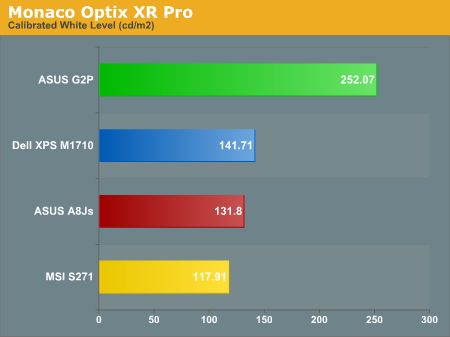
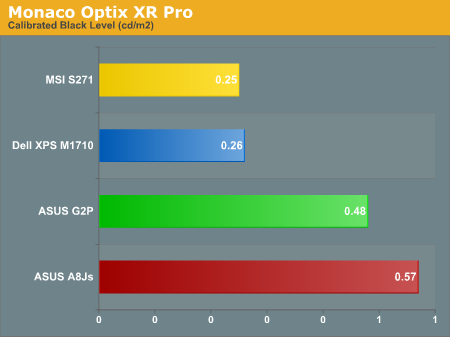
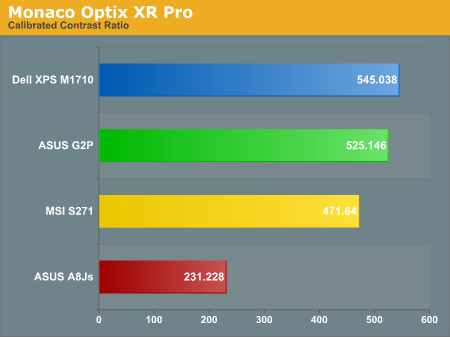
Objective testing confirms our impression that the ASUS G2P is easily the brightest display out of these laptops. The black levels may not be as dark as some people would like, but the net result is that you get a nice bright picture with a good contrast ratio. The ASUS A8Js goes the other route, offering mediocre whites and the worst blacks out of any of the laptops. This results in a very low 231:1 contrast ratio. The Dell and MSI laptops are similar in that both have dark blacks but only moderate whites. While this ends up giving the Dell XPS M1710 the highest contrast ratio, we definitely prefer the overall experience of using the G2P display.
Color Accuracy
Other than adjusting the brightness level, there's not much that can be done with a laptop to change the default color values. The vast majority of users almost certainly use no color profile, so our uncalibrated color accuracy charts will be the most meaningful for them. Some people require more accurate colors, however, and while our instinct says that none of these displays can match the quality of the desktop LCD - even the best of them seems noticeably inferior to any of the desktop LCDs we've reviewed - the only way to prove or disprove this opinion is through actual objective testing.
During testing, Monaco Optix XR Pro sends 24 color patches to the display with the colorimeter measuring the resulting values. The difference between what is requested and what the LCD actually shows is known as Delta E, with lower values being better. Any score less than one is basically "perfect" - the naked eye is not going to be able to tell the difference - and scores less than 2.0 are very nearly perfect. Ideally, for accurate colors you would want all of the tested colors to have a Delta E of less than 1.0, but almost no one is likely to have problems with anything scoring below 2.0. From 2.0 to 4.0, most people still won't notice the slight inaccuracies in the color palette, but when comparing displays side by side differences may be apparent; multimedia professionals would prefer something better. Anything above 4.0 begins to represent a more significant deviance, and numerous scores above 6.0 will almost certainly be noticeable by just about anyone. Beware also of spikes in the Delta E charts, as a low average Delta E with several high spikes may not be as good in actual use as a display that offers a higher average Delta E but without the spikes.
Uncalibrated Results
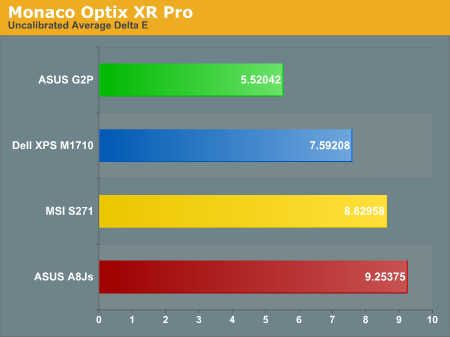
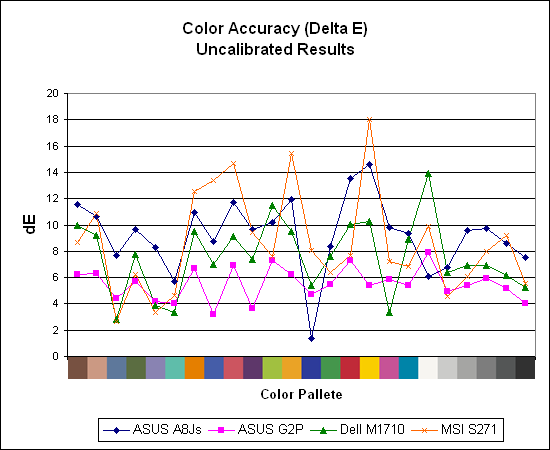
Without any form of color correction, the color accuracy of all of these displays is poor. The ASUS G2P clearly generates the best overall score with a Delta E result of 5.52. However, there are still plenty of colors that fall above the 6.0 threshold, and even one that hits 8.0. As bad as that might seem, the other three displays are clearly worse. The XPS M1710 places second by a reasonable margin, but with several colors showing a Delta E of over 10.0 it's certainly nothing special. The MSI and ASUS A8Js both exhibit extremely poor color accuracy, with multiple large spikes on certain colors. We've seen some relatively poor uncalibrated results on desktop displays that have been turned around after calibration, so let's see if that's the case here.
Calibrated Results
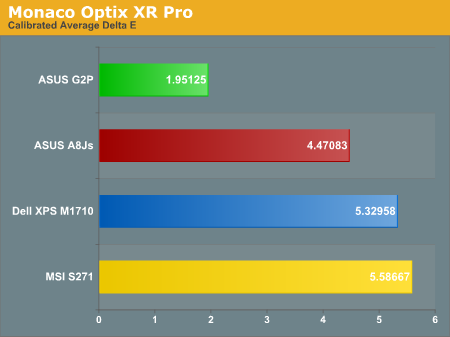
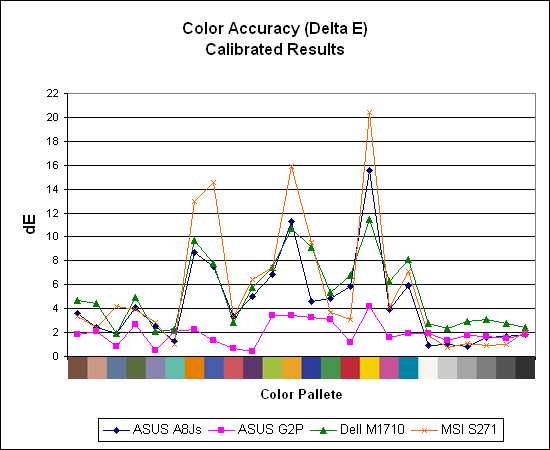
If you were hoping for a turnaround after calibration, the above charts are probably pretty disappointing. As we've mentioned several times already, the ASUS G2P is far and away the best LCD out of the laptops we've used, and the calibrated color results bear this fact out. By no means are the results perfect, but with an average Delta E of 1.95 it at least comes relatively close, and only one color actually falls above the 4.0 threshold.
The other three laptops all get lower average Delta E scores after calibration, but they all have very similar curves with certain colors that simply cannot be accurately displayed. Yellows and blues in particular seem to present problems for many laptops, and there are a few colors that actually got worse after calibration! The backlighting used on a display can have a very large impact on the color accuracy, and we would venture to guess that most laptops are using similar low-power lamps that don't cover a lot of the standard NTSC color gamut. For anyone that's serious about doing image editing work on a laptop, consider this a warning that you will want to get a separate desktop LCD if possible in order to get a better representation of colors.
Viewing Angles
Viewing angles are one of those specifications that have become very inflated by the manufacturers. The basic requirement is that a display has to maintain a 10:1 contrast ratio in order to qualify as "viewable". The reality is that most LCDs are unfit for viewing outside of about a 45° arc, and on laptops you may not even get that much of a viewing arc. While we doubt that most people would want to view a display from an oblique angle, the typical positioning of a laptop - sitting on your lap only a couple feet from your eyes - can make viewing angles more important. Unfortunately, as all of the LCDs appear to use TN panels, that means viewing angles become more important and the technology becomes less satisfactory.
We used a Canon Digital Rebel SLR camera to take shots from head-on as well as from the left, right, top, and bottom at ~30° angles. We then combined the images into a single representative shot, showing how brightness and contrast ratios are affected in off-angle viewing. The camera was set to manual mode and an ISO value of 400 with an exposure time of 1/60s. While there's no substitute for actually sitting in front of a display yourself and using it, we did our best to use settings that generated images similar to what we saw in person. With all of the laptops photographed under the same conditions and with the same settings, the relative appearance of the images is at least as important as how each image looks individually.
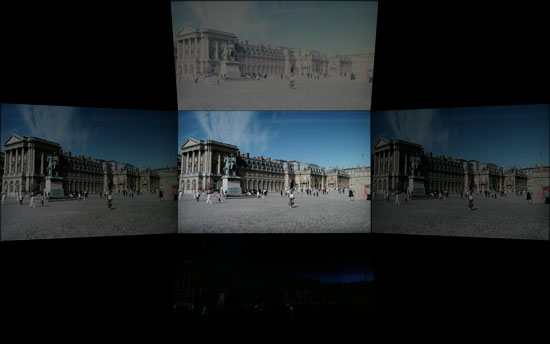 ASUS A8Js 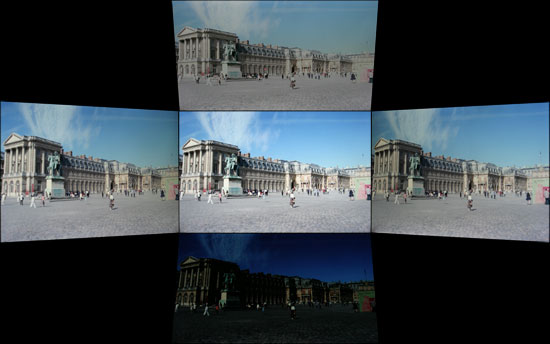 ASUS G2P 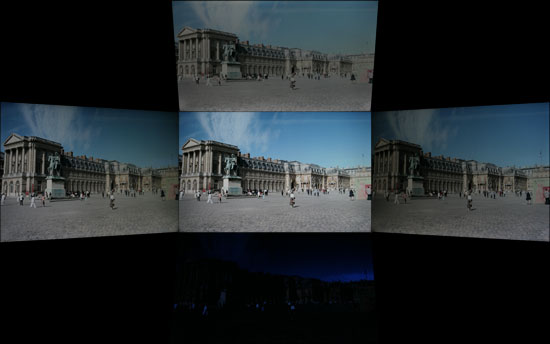 Dell XPS M1710 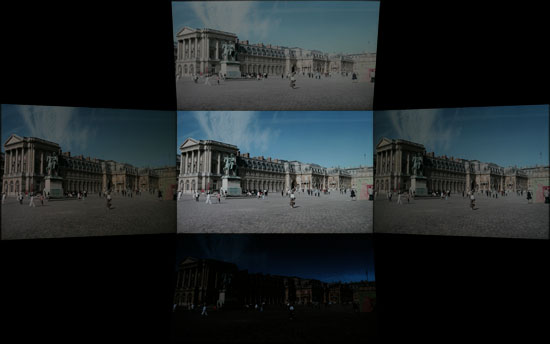 MSI S271 |
| Click to enlarge |
Again, the ASUS G2P clearly comes out on top and offers the best overall viewing angles. The Dell XPS M1710 and MSI S271 are somewhat similar, though we would give the edge to the Dell laptop. The ASUS A8Js on the other hand ranks at the bottom, particularly in the areas of vertical viewing angles. On desktop systems, horizontal viewing angles are often more important, but in everyday use we find that vertical viewing angles are definitely a problem with many laptops. A slight tilt of your lap or a straightening of your back, and the perceived image can quickly become washed out.
Response Times
Another topic that almost always comes up with LCDs is their response times, especially when compared to CRTs. Of course, on notebook computers technologies like CRTs are not a viable option - not unless you want to haul around one of those old 40 pound Compaq boxes with a 4" display that hides behind the fold down keyboard? (Ed: ah, those were good times!) While even the best desktop LCDs still exhibit some slight pixel smearing, the vast majority of users are okay with the level of performance now available. Considering that laptops now seem to be lagging behind desktops by a couple years in terms of quality and features, though, how do the laptop LCDs fare?
Since we were unable to send the same image simultaneously to multiple laptop displays, we resorted to simply taking pictures of a familiar scene from 3DMark03. We used the first game test in part because it has higher contrast images that make the frame transitions more visible, but also because at least one of the laptops struggled to get above 60 frames per second even at seriously reduced resolution and quality settings. (We ran the MSI at 640x400 rather than the native 1280x800 because the IGP would otherwise average in the low teens on frame rates, resulting in overlapping frames. The other laptops were run at their native resolutions and experienced no difficulties with this rather old benchmark.) We took numerous pictures on each laptop, and then selected one that seemed to best represent the performance. Here are the images we captured:
 ASUS A8Js  ASUS G2P  Dell XPS M1710  MSI S271 |
| Click to enlarge |
We couldn't find any manufacturer specifications suggesting what sort of response times we should be experiencing with any of these laptops, but judging by the above images we would venture to say that a rating of 25ms or lower would be appropriate. You can clearly see at least three frames on every one of the laptops, sometimes more. The A8Js and XPS M1710 both show four frames, although at least one of the frames is barely visible on each laptop. Since we also have to account for shutter lag on the camera, we would say that these two laptops appear to take around two frame updates resulting in an approximate response time of 33ms. The G2P and S271 on the other hand appear to take somewhere between one and two frame updates, giving them a response time of between 16ms and 33ms.
Considering that some of these notebooks really won't be used for gaming anyway (particularly the MSI S271), response time is not necessarily a critical factor. However, we certainly wish an "extreme gaming" laptop like the Dell XPS M1710 could provide better response times, and more importantly better overall display quality.
Closing Thoughts
The results of our testing are at the same time both surprising and somewhat expected. They are expected when we consider that using only our naked eyes, we can clearly see that all of the displays provide a less desirable image than just about any desktop LCD we have used in recent years. The surprising aspect is just how bad many of the displays scored, particularly in terms of color accuracy. While there are almost certainly other laptops that have LCD panels that can rival the ASUS G2P, there are plenty of others that more likely than not rate about as high as the ASUS A8Js. We're also more than a little shocked that ASUS managed to provide both the best and worst display experience of this roundup, which goes to prove that there's far more to this than simply choosing a reputable manufacturer.
We will continue to review this important aspect of notebook computers on all future laptop reviews, and over time we will be able to see how future products compare to this initial roundup. Sadly, unlike with desktop systems you can't simply choose which display suits you best and pair that up with the components you want. If that were the case, we would at minimum want notebook displays that could match the quality of the ASUS G2P, whether in 12", 14", 15", or 17" notebooks. In fact, the G2P has become one of our favorite notebooks simply because of the stellar display quality relative to other notebooks, and since we don't often require high-end gaming performance from a laptop we would be more than willing to sacrifice some graphics performance in order to get a better display. Of course, not everyone would agree with that sentiment.
As good as the ASUS G2P is when compared to these other notebooks, however, the overall display quality is still clearly inferior to most desktop LCDs. Viewing angles are similar to what we have seen on the 22" LCDs, and the Acer AL2216W has the worst viewing angles of any of the high-end desktop LCDs that we've reviewed so far; it makes us wonder where the S-IPS and S-PVA notebook LCDs are hiding. Color accuracy is also still an order of magnitude lower than any of the desktop LCDs we've looked at in the past six months, and although we find it more than sufficient for our use we imagine imaging professionals at the very least would want something better. For a 17" laptop, we would also prefer a native LCD resolution of at least 1680x1050 (without sacrificing the brightness and other qualities currently offered). In short, as usual, we want more!
The good news is that with many new technologies being researched and the potential for OLED displays to make all of our current LCD preconceptions a moot point in the future, hopefully the only direction to go from here is up. We're working on getting more notebooks for review, specifically some of the new Santa Rosa models, and in the very near future we will see whether anything has changed in regards to notebook LCDs. All of these laptops are, after all, at least six months old. However, notebook computers do tend to have longer life spans as they cost more and take more time to pass through the R&D process. Dell's XPS M1710 for example has been around for over a year now, with no discernible change in the LCD quality during that time. We would like to think that it's about time for some updates to arrive, but time will tell.
As a final comment, we have only tested a very small number of laptops at this point in time. We would be extremely interested in testing more displays, and if anyone has connections with some of the larger laptop manufacturers we would be interested in working with you - particularly if you feel your notebooks can excel in the area of display quality. Stay tuned for future laptop reviews where we will continue to look into this subject as well as performance and other features.







